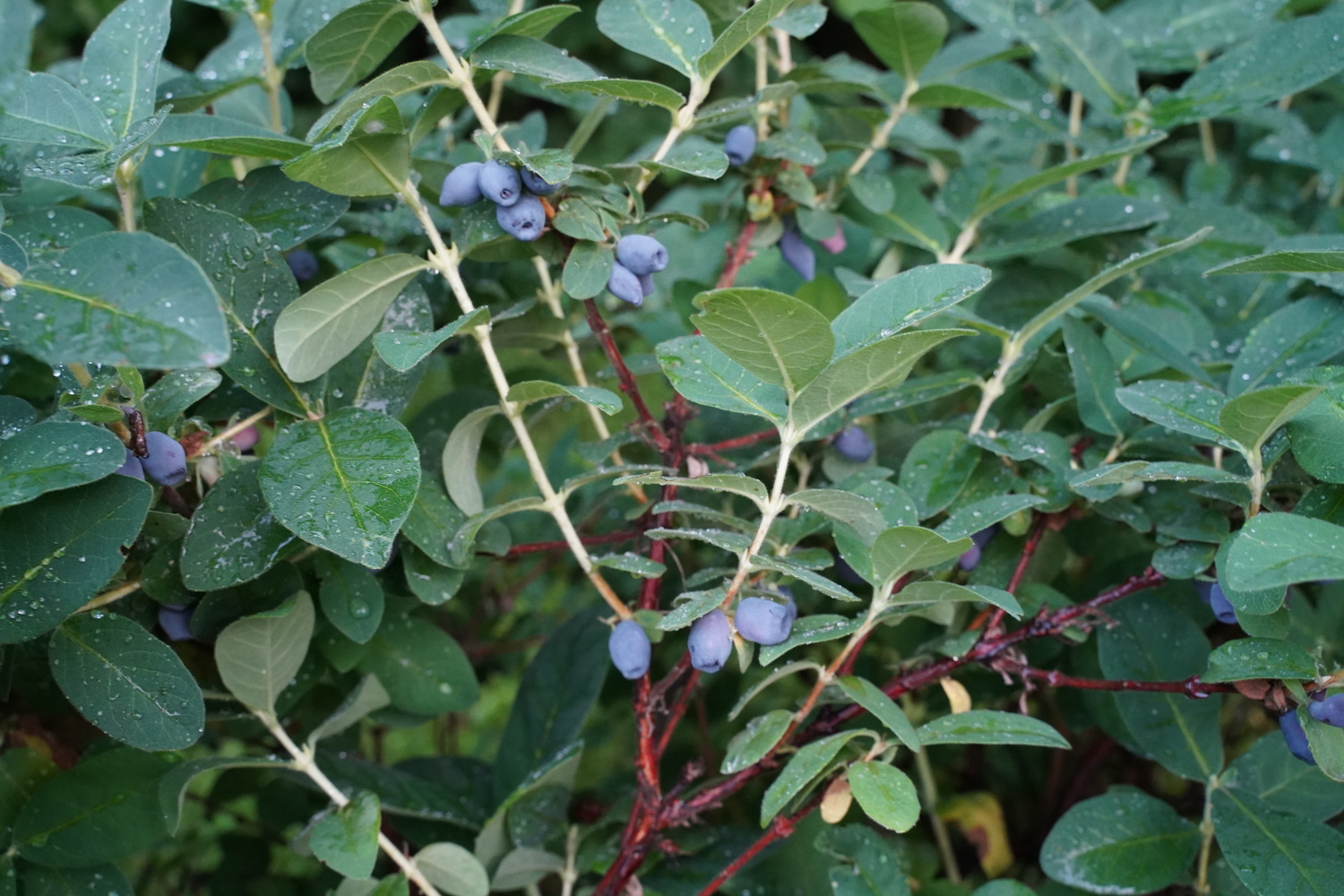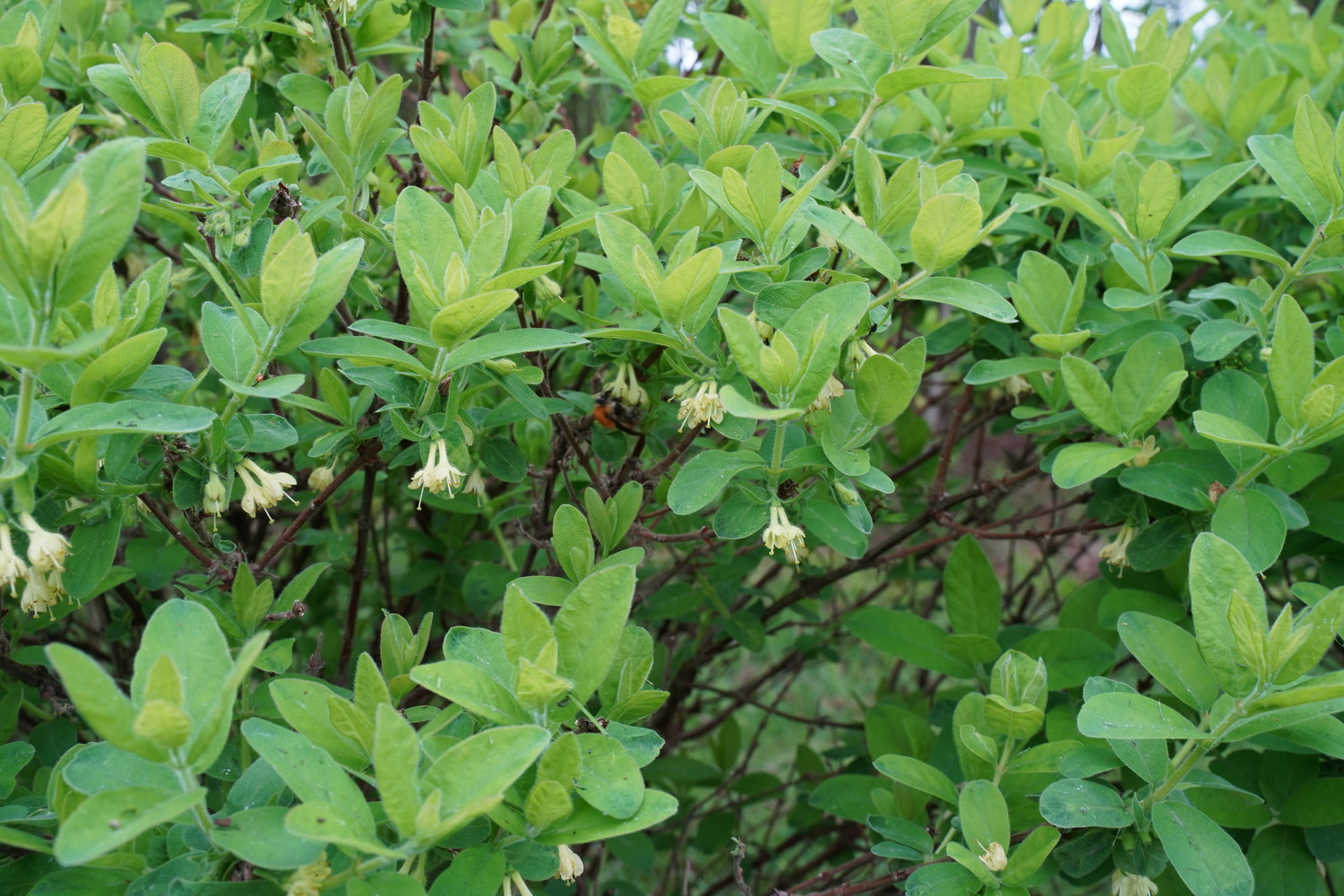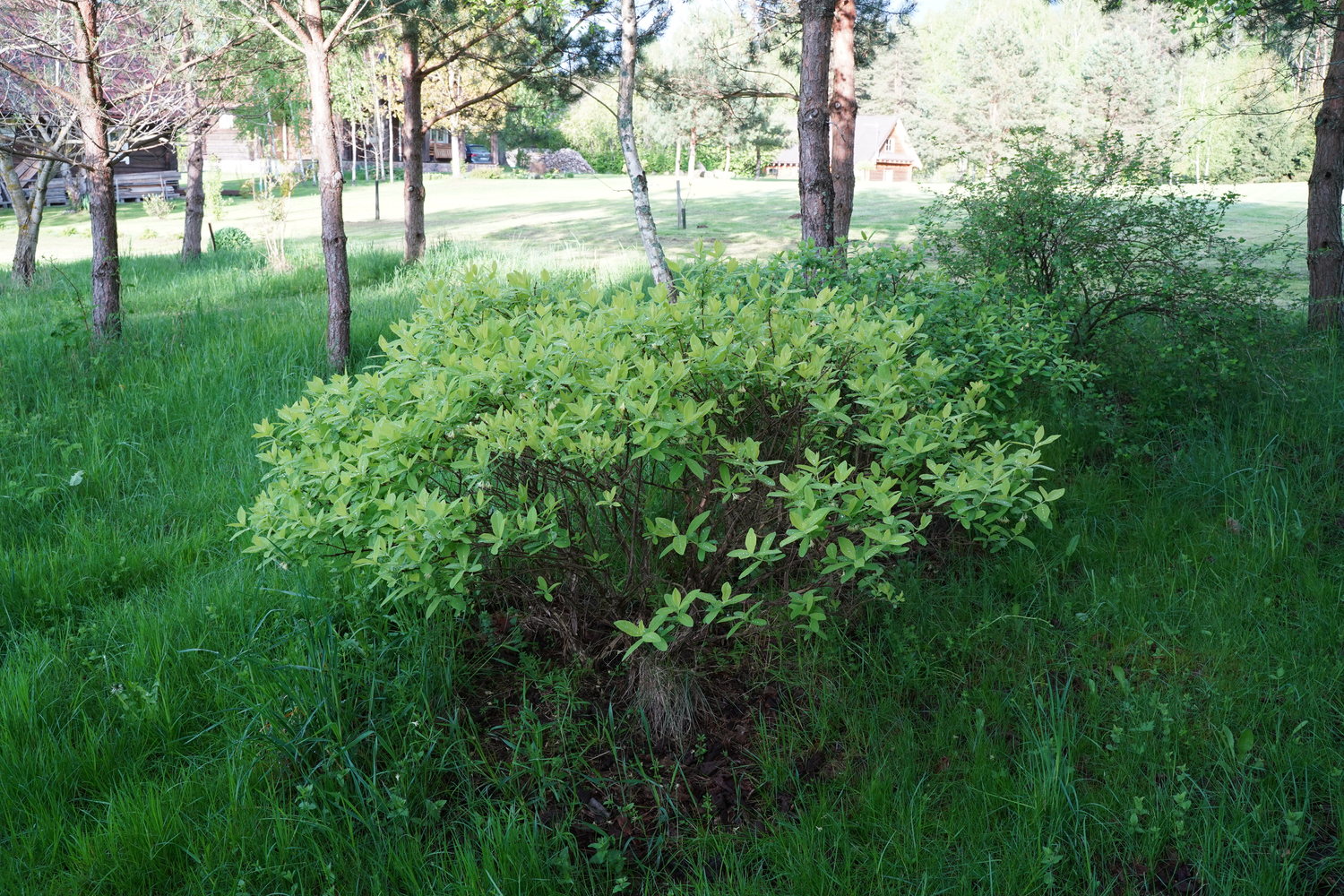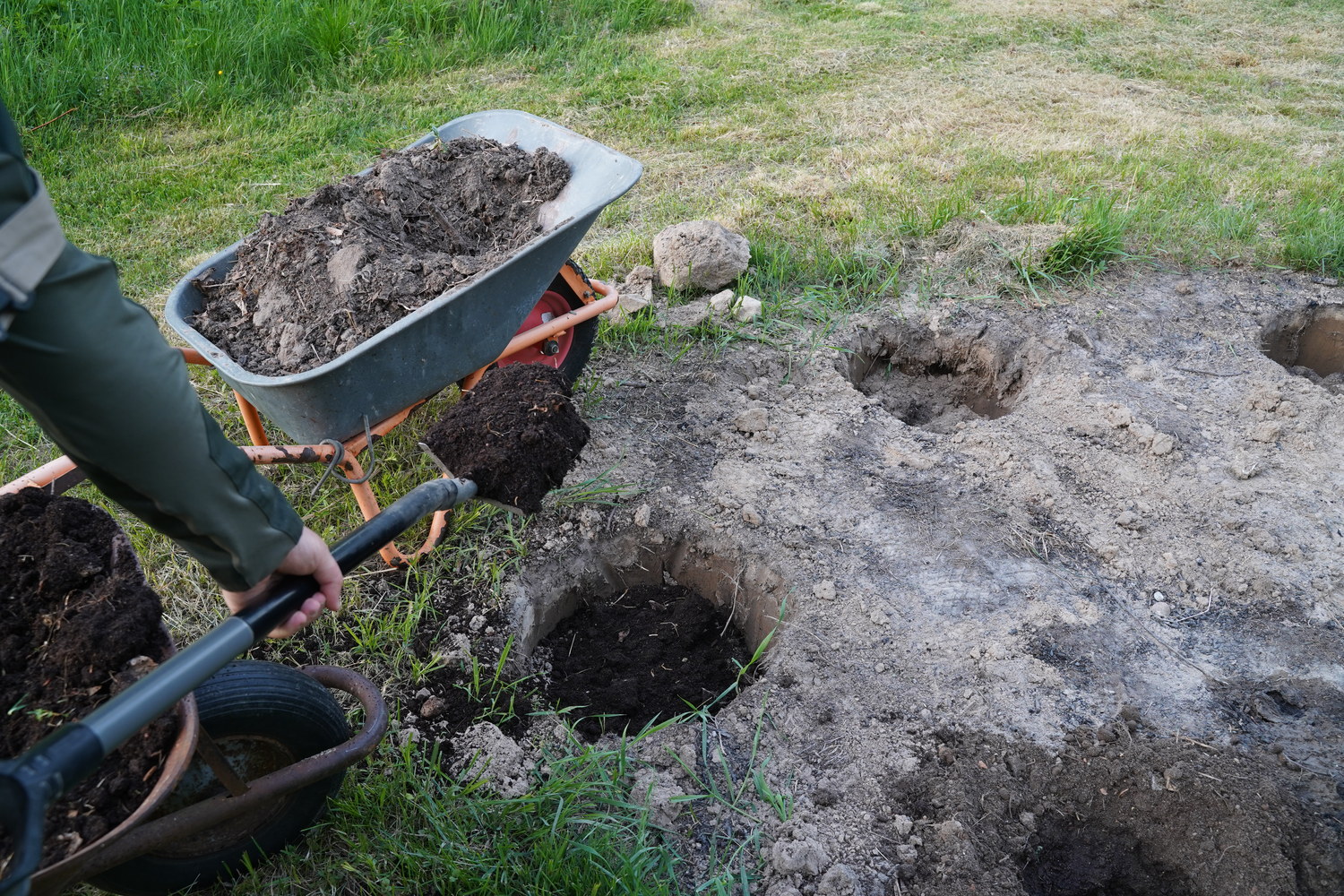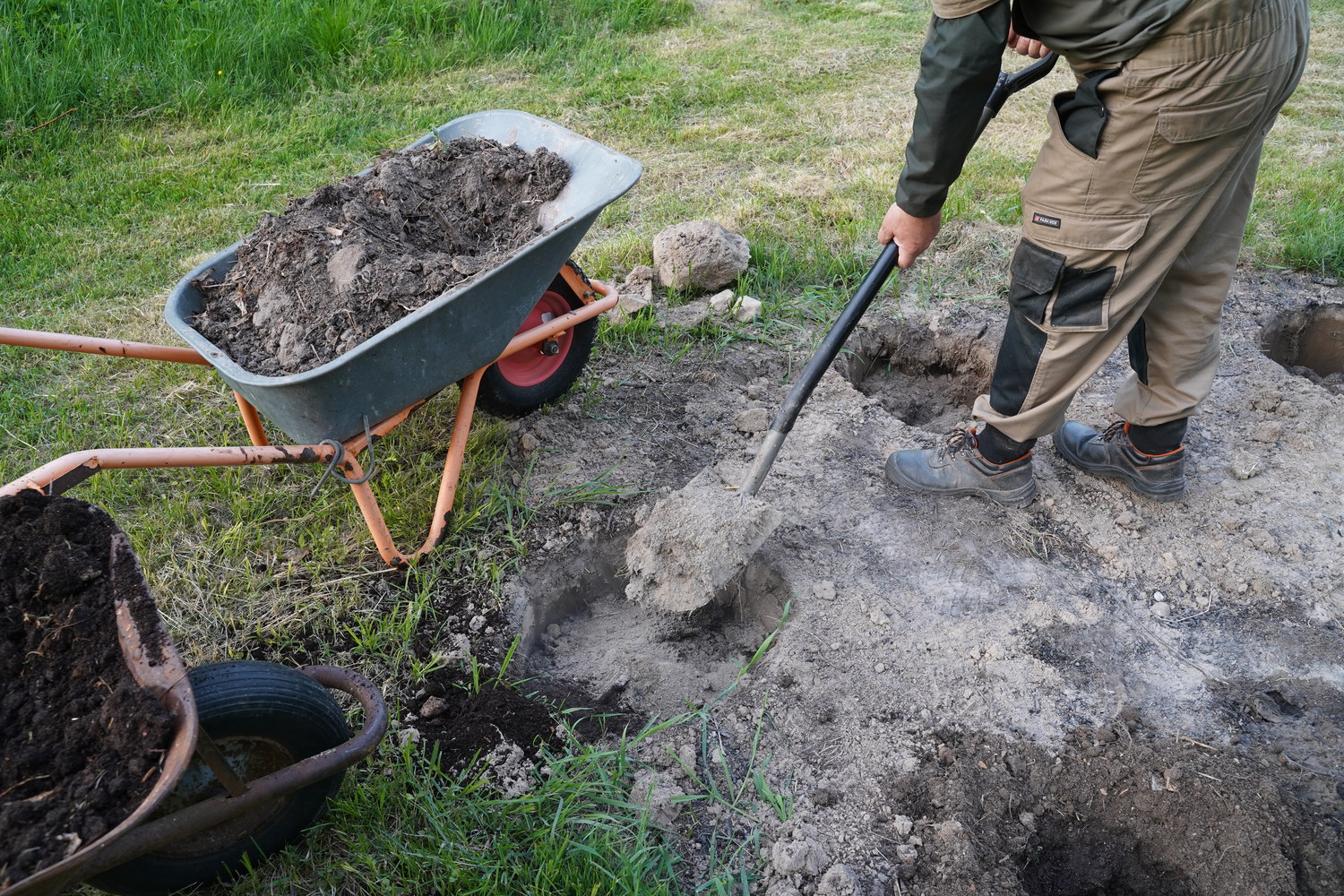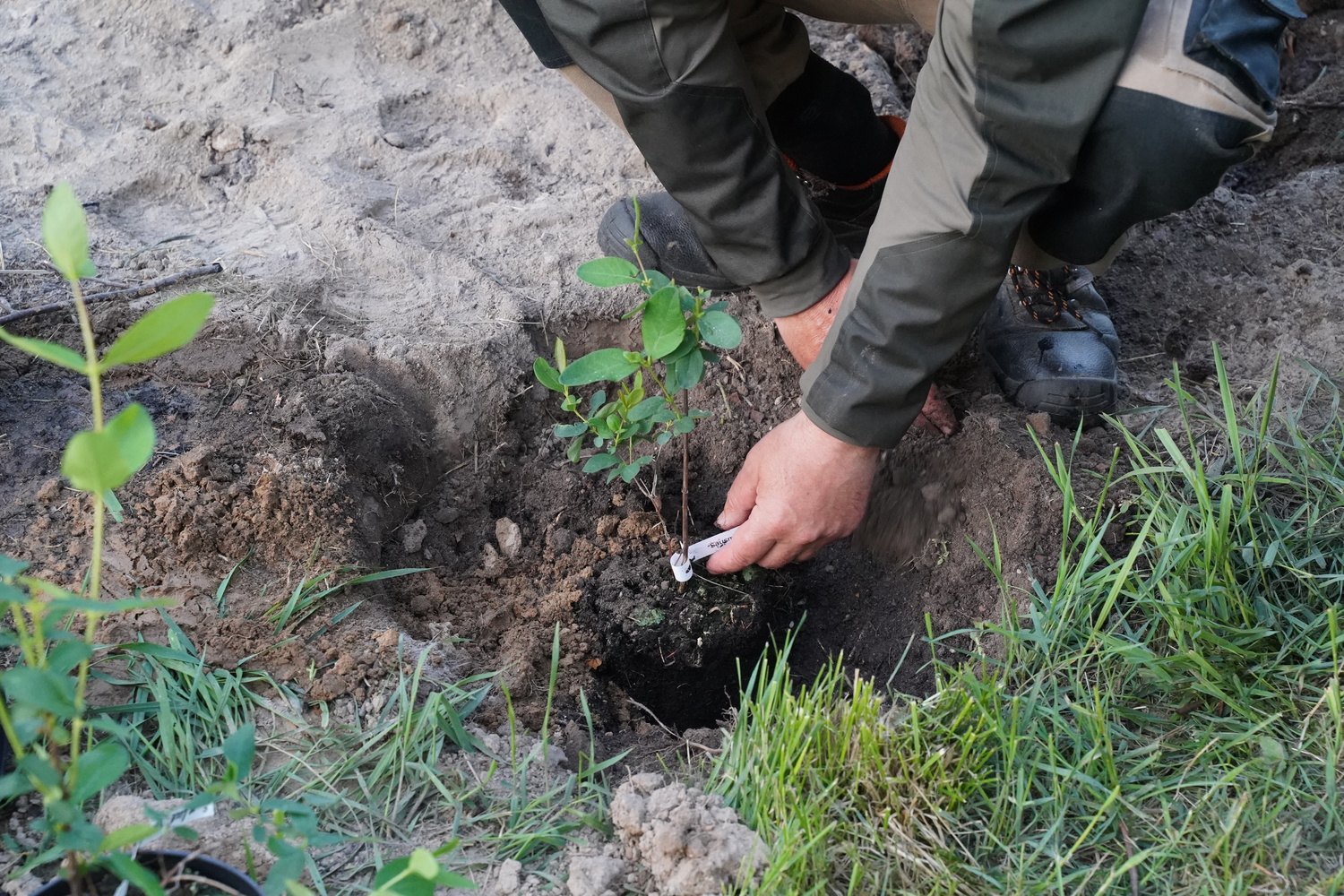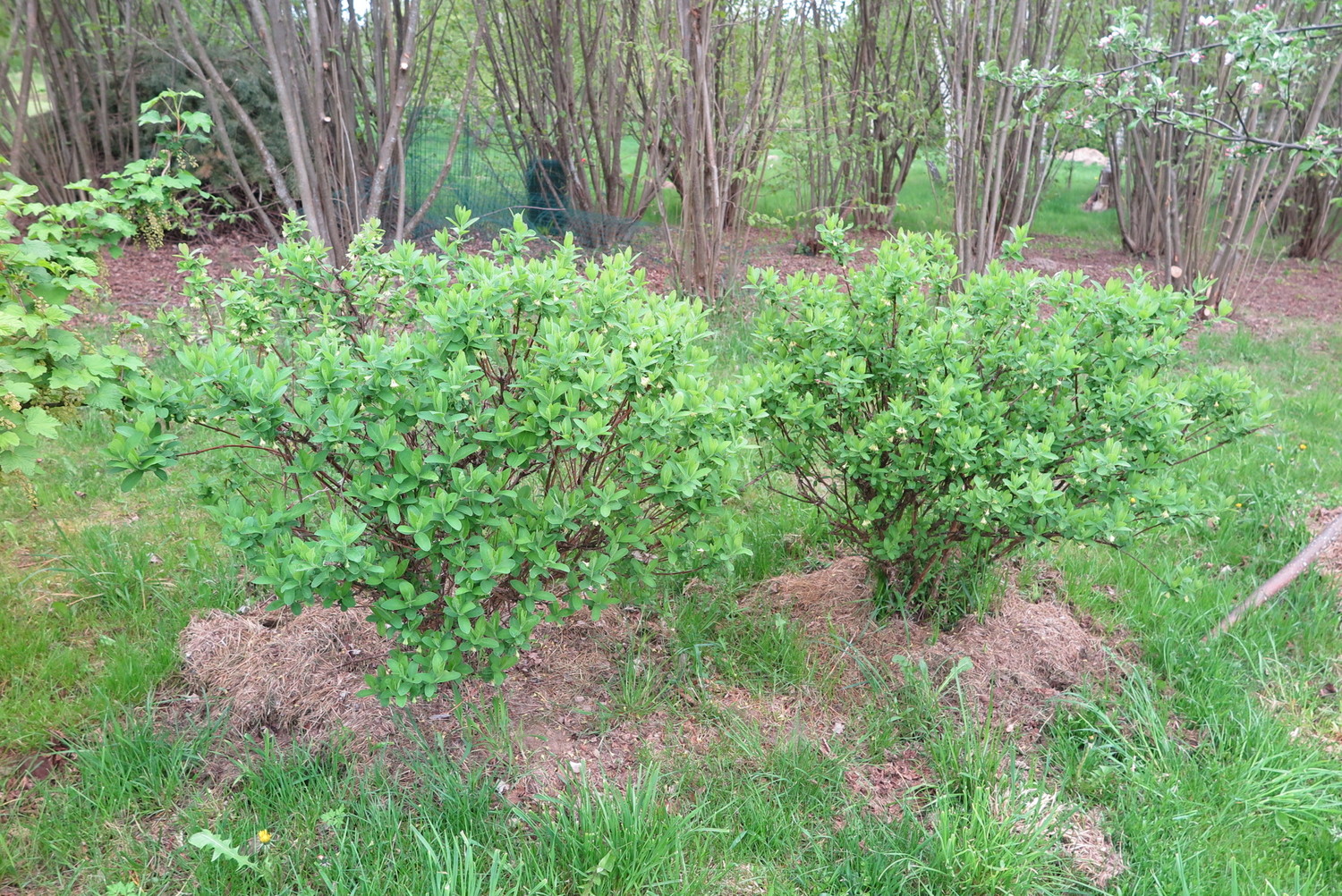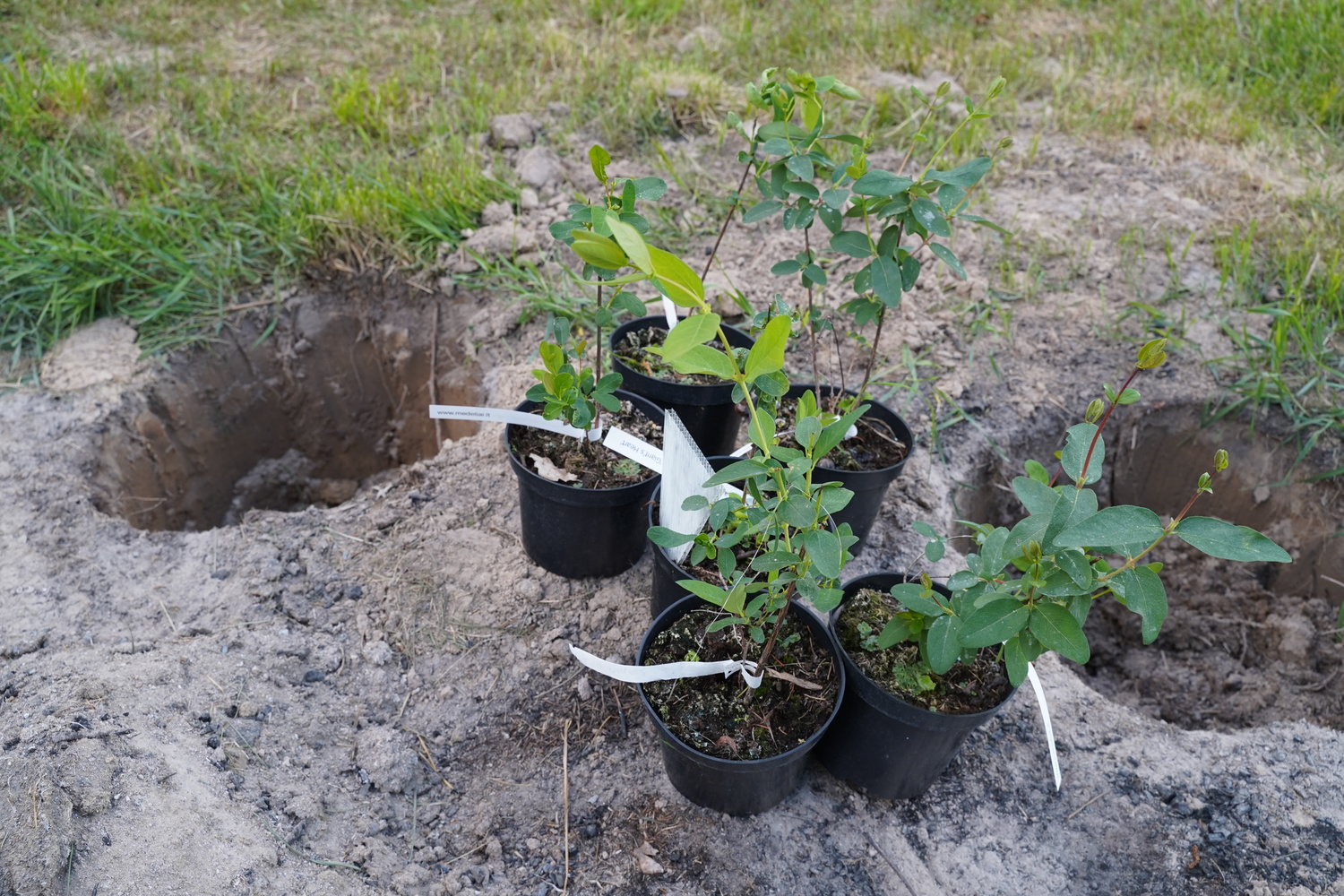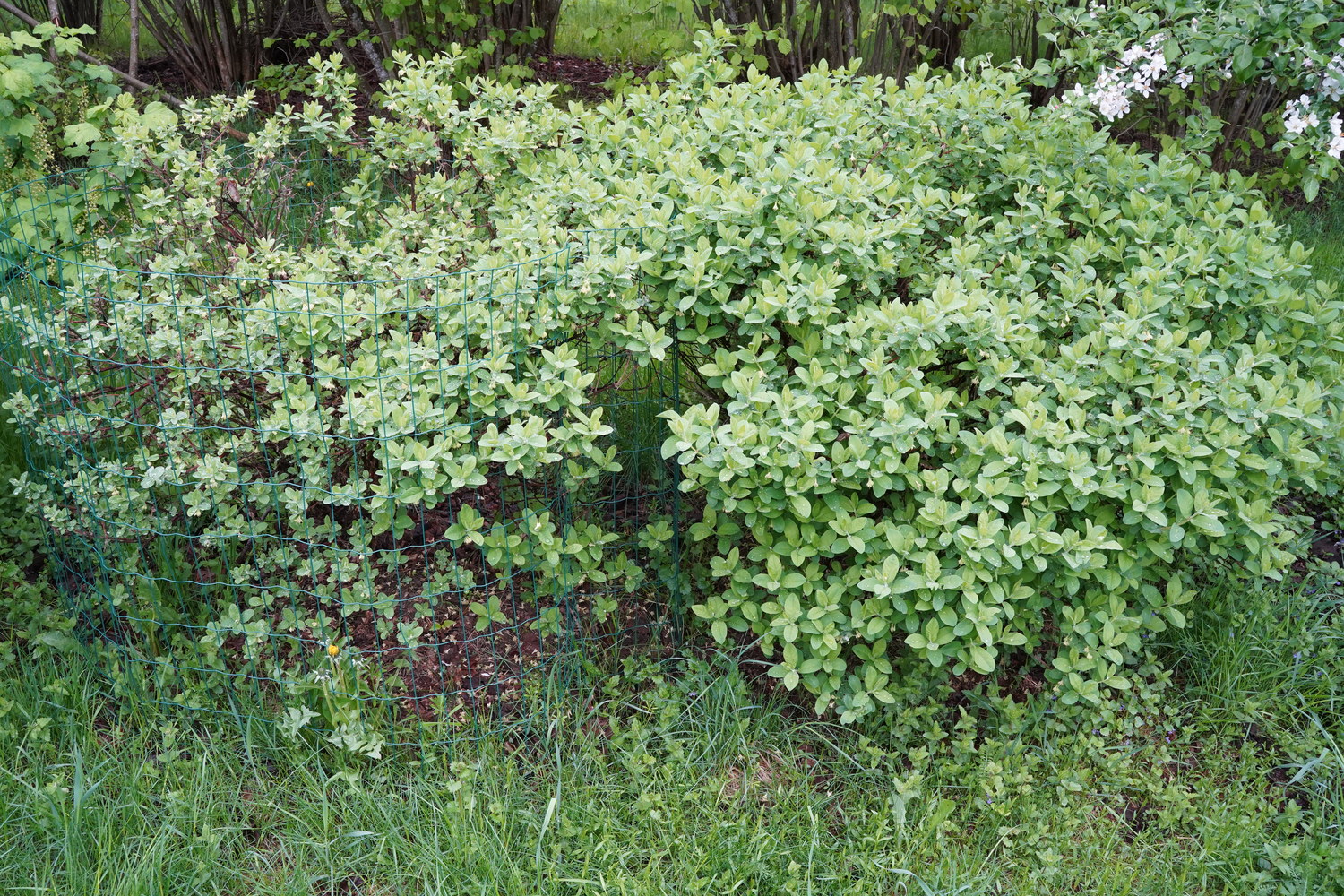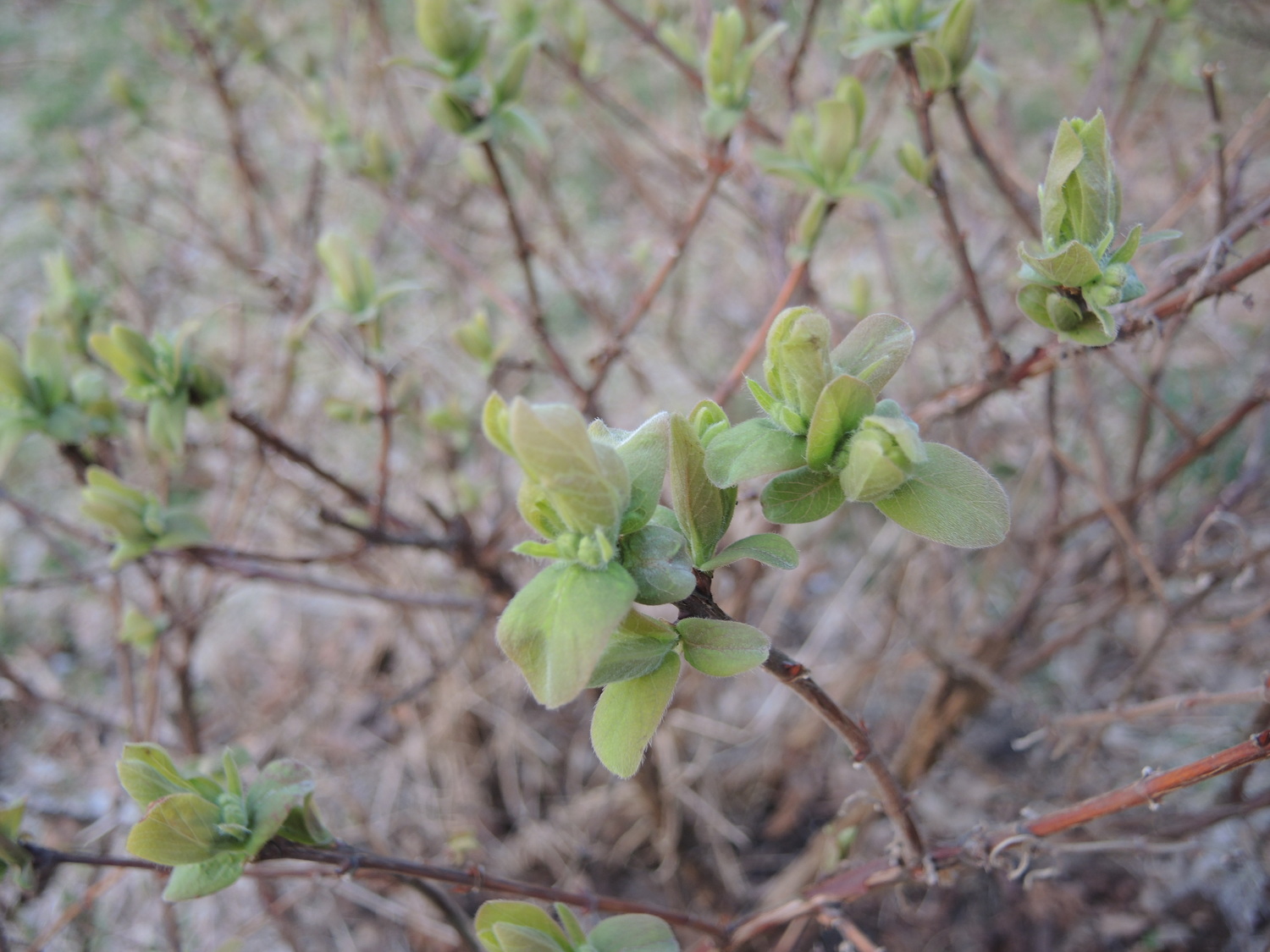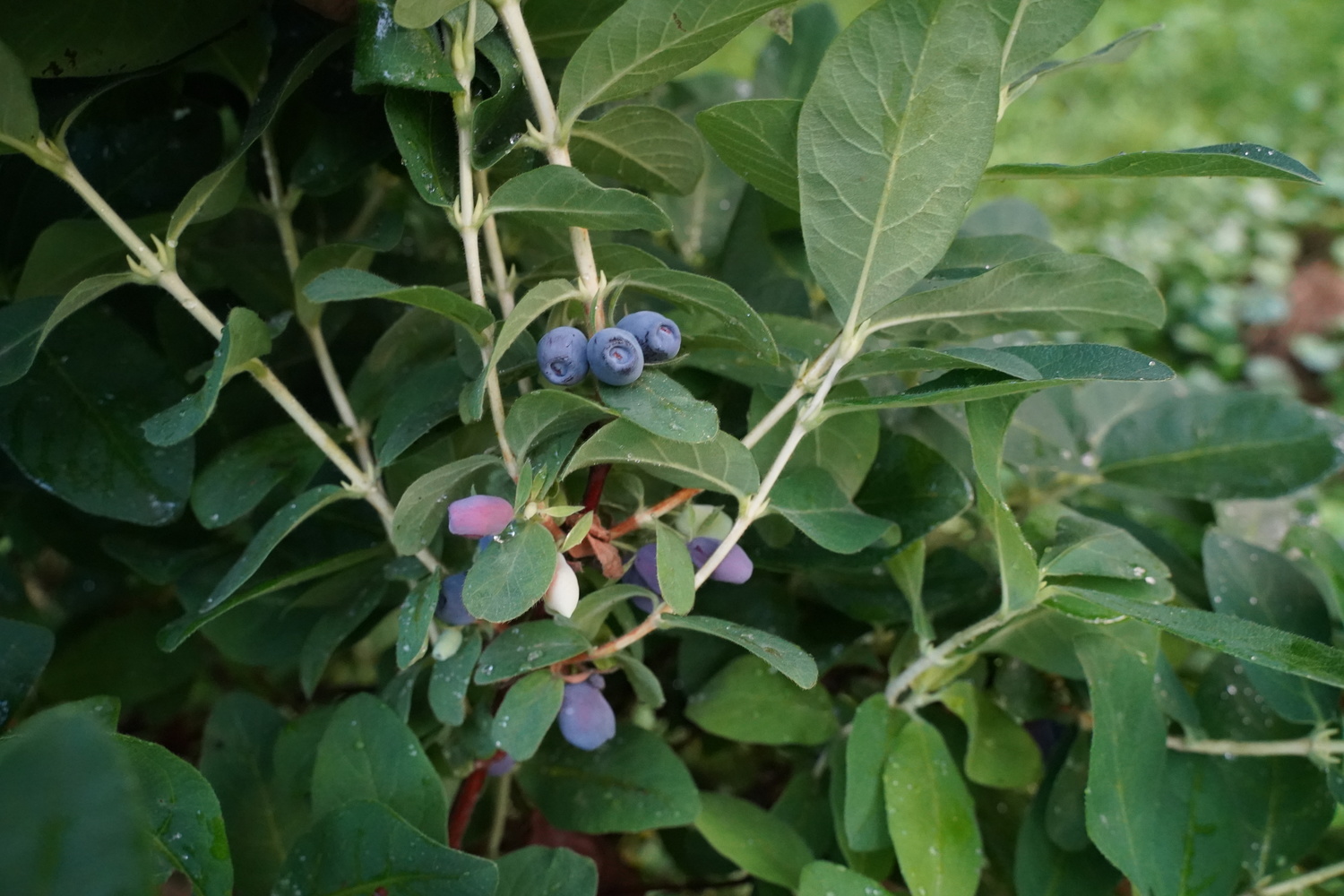The edible honeyberry (Lonicera caerulea), often referred to as the blue honeyberry, is a species of the genus Lonicera. The plant's natural distribution area is in the temperate climate zone of the Northern Hemisphere, where it grows in riparian meadows, forests, mountain tundras, and shrubs, as well as in the subalpine zone and forest belt.
Edible Honeyberry
All forms of edible honeyberry are deciduous shrubs, growing up to 2.2-2.5 meters tall. The lifespan of a blue honeyberry shrub is 50 years or more. The leaves are oval-shaped, grayish-green, and covered with a light waxy coating. Their length can reach up to 8 centimeters, and their width up to 3 centimeters. The leaves are arranged opposite each other. Flower buds form on the previous year's shoots and begin to develop a few days after the spring warmth. The flowers are small, up to 2 centimeters in size, yellow, and bell-shaped in pairs. They appear in mid-March. Depending on the weather conditions, blooming lasts 20-25 days.
The blue honeyberry flowers are hermaphroditic, but the plant is self-fertile. Cross-pollination is necessary for fruit set.
The more different varieties are grown in the same garden, the higher the yield. If only one variety is planted, even with abundant flowering, the yield will be poor.
Honeyberries grow quite compactly, making them easy to harvest. Some varieties, especially older ones, have different ripening times. This makes large-scale harvesting difficult but can extend the eating season.
The fruits of the blue honeyberry are elongated blue berries, somewhat resembling huckleberries in appearance. Their diameter is about 1 centimeter, and their length can reach up to 5 centimeters. The mass of the berries can exceed 3 grams. The flesh contains up to 20 small, almost imperceptible seeds. The fruits have a pleasant taste with a characteristic bitter aftertaste, which is especially pronounced in older varieties. The fruits acquire their distinctive color 1-2 weeks before full ripeness, so it is crucial to ensure the berries are fully ripe before harvesting, as unripe berries have a poor taste. The juice of the berries is dark and strongly staining.
Currently, breeders aim not only to improve the taste of dessert fruits, extend their shelf life, and increase yield but also to make the berries more suitable for mechanised harvesting. New Russian and Canadian varieties feature firmer, more uniformly ripening berries with a dry pedicel and thicker skin. These traits allow for the efficient use of mechanised harvesting and sorting. Berries can be stored in traditional cold storage for up to two weeks. However, selection work is still ongoing to extend the storage duration. Some varieties of fruits can be stored for 3-4 weeks.
The fruits of older varieties of edible honeyberries typically have a sour and astringent taste. Newer varieties of edible honeyberries are mainly characterised by a dessert-like flavor. Their fruits are sweet, without the sour-bitter aftertaste. Blue honeyberries ripen first during the season—in May—earlier than strawberries and six weeks before blueberries.
Blue honeyberry shrubs yield fruit yearly, and their productivity increases until they are about 15 years old. Two-year-old seedlings begin to bear fruit in their second or third year after planting. The average yield is about 3 kilograms per bush, although in some cases, it can reach up to 8 kilograms.
Properties of Edible Honeyberries
The fruits of the edible honeyberries are rich in various vitamins and minerals. They contain carotene (provitamin A), thiamine (B1), riboflavin (B2), folic acid (B9), pyridoxine (B6), rutin (P), as well as pectins and tannins. The fruits are high in macroelements beneficial for the body, such as magnesium, barium, sodium, potassium, calcium, and phosphorus, as well as microelements like manganese, copper, silicon, and iodine.
In terms of vitamin C content (40-60 mg %), blue honeyberries are on par with lemons. According to some sources, the vitamin C concentration in the leaves can reach up to 200 mg %. The berries also contain a significant amount of antioxidants and polyphenols, with levels several times higher than those found in common blueberries (Vaccinium myrtillus).
The ORAC value (antioxidant capacity to neutralise free radicals) of blue honeyberries is 13,400 µmol/100 g, which is one of the highest results among fruits. The berries are characterised by a high content of dry matter (19%) and sugar (12.5%), the majority of which is glucose (75%), as well as fructose, galactose, and other compounds.
Thanks to these substances, blue honeyberries are beneficial for the prevention of cancer, heart disease, and diabetes.
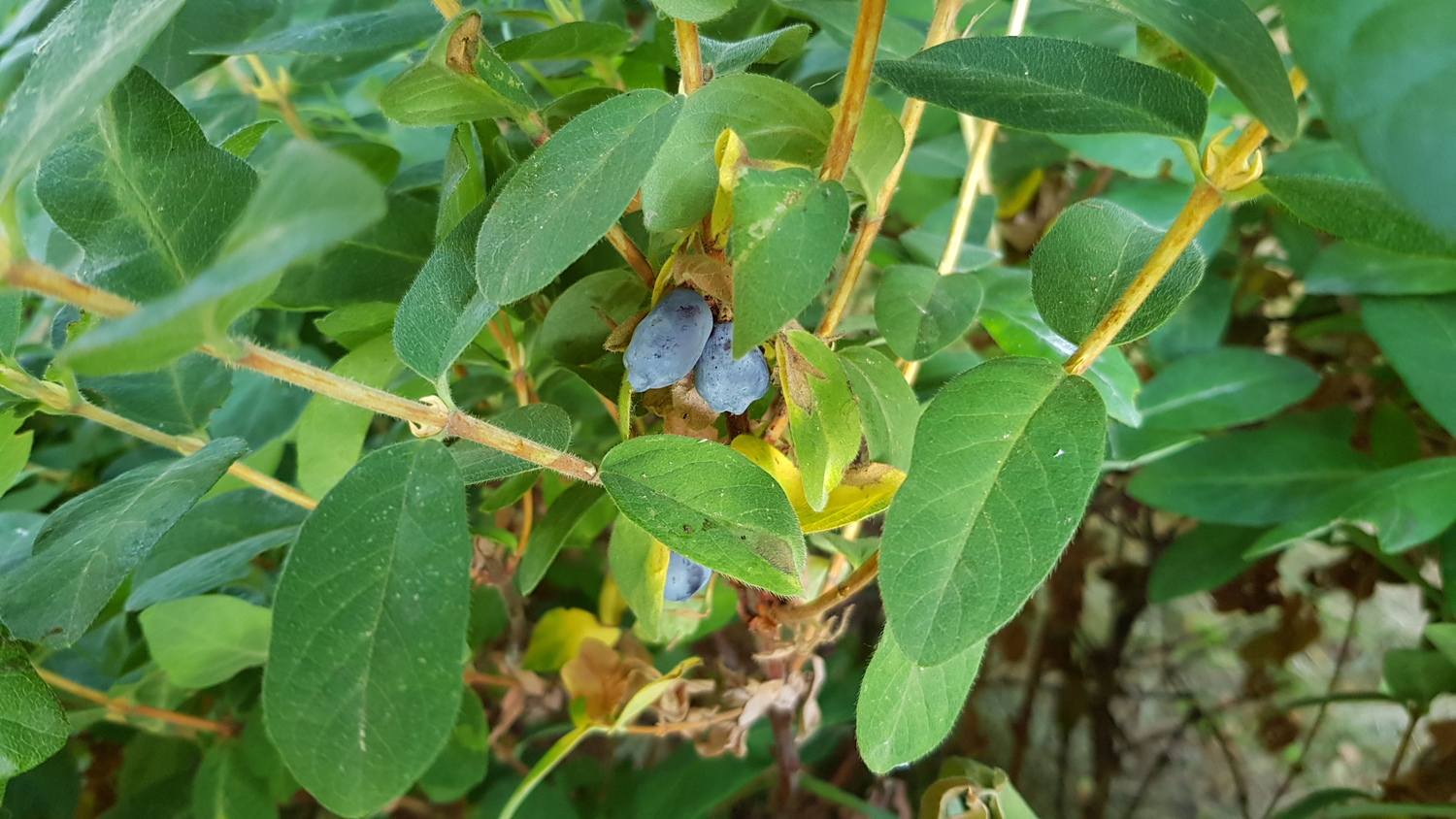
The Best Location For Honeyberry Growing
This plant prefers sunlight and does not bloom or bear fruit in the shade. The sum of active temperatures required for the plant's growth and fruit formation is between 420-520 °C. To ensure a good yield, it is necessary to plant at least 2-3 different varieties. The plant is not particularly demanding in terms of soil, as it tolerates a wide range of acidity, from 3.9 to 7.7 pH, but the best results are achieved when it grows in slightly acidic or neutral soils (pH 5.5-6.5). The plant prefers moisture but cannot tolerate waterlogging. During dry spring periods, irrigation is necessary during the active growth and fruit formation stages, as a lack of water reduces the yield and negatively affects the taste of the fruits.
Honeyberry shrubs are planted in a circle, serving as a decorative element in the landscape. Similarly to this, blueberries are planted a little farther apart. Planting in a circle has many advantages. While the honeyberry reaches about 50-70 centimeters, it should be protected from deer, as they tend to nibble on the tops. The circular arrangement makes it easy to surround the plants with a continuous fence during the winter. By planting taller shrubs on the northern side and shorter ones on the southern side, a balanced amount of light is ensured for the shrubs. This also improves flower pollination.
Honeyberry Pruning
In the first 5-7 years, only sanitary pruning is performed. In later years, when the crown becomes dense, a rejuvenating pruning procedure is recommended, which is best done in the fall, after the leaves have fallen, or in early spring (March-April). Aging elements of the crown should be pruned 30-50 cm above the point where a large stem shoot grows. When performing major crown renewal, a strong pruning technique is applied—cutting back to the stump, leaving about 0.5 m from the ground.
An 8-year-old honeyberry bush. The crown is formed, and each year, branches growing inward, as well as dried and weak branches, are removed.
In the first year after planting, honeyberry is usually not pruned, as the plant is still establishing itself in the soil and forming its root system. Pruning is not necessary, but it is important to ensure proper watering and nutrition to help the plant strengthen.
In the second year, the honeyberry begins to grow more actively, but pruning is still not needed unless damaged or diseased branches are removed. During this period, it is crucial to ensure that the plant develops symmetrically and does not produce undesirable shoots.
In the third year, you can begin shaping the plant's crown. Weak, inward-growing, or crossing shoots are removed to ensure good light penetration. Pruning is done in the spring, before the start of the growing season, while the plant is still dormant.
By the fourth year, the honeyberry is well-established, so thinning pruning is performed. Old, weak, or damaged branches are removed to allow the plant to continue growing actively and forming a strong crown.
In the fifth year, a light formative pruning is carried out. Excessive shoots that interfere with the plant's ability to form a symmetrical and open crown are removed. Overly long branches may also be shortened to maintain the balance of the crown.
In the sixth year, rejuvenating pruning is performed if the plant begins to form too dense a crown. Older branches are removed to encourage the growth of new shoots. This process improves productivity and ensures that the plant does not waste energy maintaining old branches.
In the seventh year, the honeyberry has reached its maturity. Annual sanitary pruning is performed, during which dry, diseased, or damaged branches are removed. Minimal thinning can also be done if the crown becomes too dense. This type of pruning ensures the plant's health and stable yields in the coming years.
Honeyberry flowers form on the buds of the upper branches from the previous year. The goal of pruning from the fourth year onward is to create as many strong honeyberry branches with upper buds as possible. This can be achieved by preparing some of the branches for the following year’s harvest by pruning them in early spring, leaving a few buds from the previous year. These branches will not flower but will grow 3-4 new shoots.
Honeyberry Planting
The plant easily tolerates transplantation at almost any age. It is best to plant it in late autumn. Plants with a closed root system can be planted from spring to late autumn. The recommended spacing between plants is 1.5-2 meters.
The mixture is stirred in the hole, and a hole is made for the seedling. A bucket of water is poured in, and you wait for it to be absorbed.
The soil mixture should consist of soddy soil, well-rotted manure, and peat or sand in a 3:1:1 ratio. The root collar should be level with the soil surface. The depth of the hole should be 25-30 cm and the diameter 25 cm for 2-3-year-old shrubs. For 5-7-year-old shrubs, the hole should be 50 cm deep and wide. To ensure fruiting, at least 3-5 different varieties of shrubs should be planted. When planting, 5-7 kg of manure, 50-80 g of superphosphate, and 40-50 g of potassium salt should be added to each hole. A drainage layer of broken bricks or gravel, 5-7 cm thick, is recommended at the bottom. During planting, pruning of the branches is not necessary – this is done in the spring before the strong buds appear. For spring planting, the branches are pruned immediately.
Edible honeyberry seedlings are most commonly sold in containers. They are usually planted at the same depth as in the container or slightly deeper.
Honeyberry Care
The plant responds positively to fertilisation and watering. In the first two years, it is recommended to fertilise with nitrogen fertilisers in the spring. Dissolve 30 g (a matchbox) of urea or ammonium nitrate in 10 liters of water and water the plant with 1-1.5 liters per plant. Watering can be done through the leaves and the roots, providing additional feeding. Such fertilisation can be done every 2 weeks from the beginning of the growing season until mid-June. Due to the abundant mineral fertilisation, reserve buds may begin to develop, resulting in additional shoots, thickening the crown.
Varieties of the Edible Honeyberries
All varieties of edible honeyberries have high frost resistance. When choosing edible honeyberries, it is crucial to consider the ripening time, as this can extend the harvest period. The choice can also be based on the size of the berries and their taste characteristics. Additionally, you can select based on the plant's growth habit; most honeyberries are about 1.5 meters tall, but there are shorter and taller varieties. Shorter varieties can be planted on the northern side, with taller ones planted to the south of them. This way, the plants will receive enough sunlight from the southern exposure.
The Diseases and Pests of the Honeyberries
The plant is almost unaffected by diseases and pests. During the ripening period, fruits could suffer being pecked on by thrushes and sparrows.
Fencing the honeyberries to protect them from possible animal interference, such as deer.
Honeyberry Propagation
This plant propagates well through green cuttings, maintaining the characteristics of the varieties. The maturity of the cutting can be checked by bending – suitable cuttings do not bend but break with a characteristic snap. Cuttings are taken at the end of flowering when the first green fruits appear. They should be cut from the middle part of the shoot, containing 2-3 internodes. The upper cut of the cutting is made horizontally, leaving 1-1.5 cm from the buds, and the lower cut is made diagonally at a 45° angle. The lower leaf blades of the internodes are removed, and the upper ones are trimmed by more than half.
Short cuttings with one internode root about 60%, while regular cuttings with 2-3 internodes root 70-95%. Shoot tips and cuttings with a heel (a break from the perennial stem at the base of the shoot) root well. If cuttings are prepared during active growth, their rooting probability is 45-60%. Unripe cuttings may rot due to excess moisture. Cuttings can root without root stimulators, but using them increases the percentage of well-developed plants.
The soil mixture for propagation should consist of peat and sand in a 1:3 ratio. The cuttings are planted at a 45° angle. The humidity of the substrate and air should be around 85%, and the temperature should be 20-25 °C. Rooted cuttings are left to grow in the same place for 1-2 years. Seed propagation is used only for breeding, as the variety characteristics do not transfer through this method.
Usage of the Honeyberry
It is a valuable honey-producing plant. The berries of the edible honeyberry are suitable for fresh consumption, and they are also used to make jams and compotes. Some varieties have a decorative, dense, semi-rounded canopy that looks beautiful without formative pruning. These plants are suitable for planting individually or in groups. Honeyberry views are especially striking when combined with columnar junipers.

